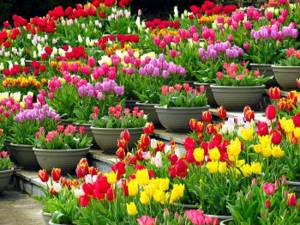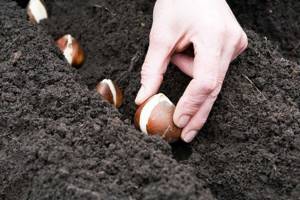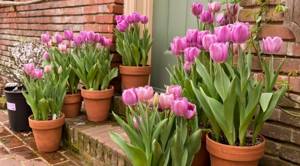Bright tulips will turn the simplest flower bed into a luxurious flower garden. But it is not always possible to plant them before winter. Don't be upset. Planting tulips in the spring, like other bulbous flowers, is quite possible. If done correctly, multi-colored hats will decorate your garden plot already this season.
- 2 Dates: general, according to the lunar calendar and in different regions
- 3 What types of planting exist: in pots and in open ground
- 4 How to prepare material for planting
- 5 How to plant in pots and open ground: step-by-step instructions
5.1 Proper planting of flowers in the ground
- 5.2 Potted tulip planting
Should I plant tulips in spring?

In spring, those tulips that survive dimming in the ground bloom profusely.
Most often, these cold-resistant bulbous plants go to winter under a layer of soil. This is done in September-October. Over the winter, tulips accumulate strength for abundant and long flowering in the spring. But it is possible to plant the beauties in March-April.
In cold regions and without forcing them in pots, they will bloom only next year: the flower bud must mature.
When pre-planted in pots, or if the soil temperature allows the bulb to acclimatize, green pets will delight you with flowering this season.
When planting tulips directly in open soil in spring, it is important to choose the right location for them. A flowerbed with oriental beauties should be protected from the wind, well lit and warmed by the spring sun. This will accelerate their growth and allow them to gain strength for rapid flowering.
Compared to “winter” tulips, those planted in the spring will not bloom so magnificently and abundantly, and the time for the appearance of bright caps will be slightly delayed. But this has its own advantage: the flowerbed will remain lush for a long time. Flowers planted in spring will be replaced by autumn flowers.
The best varieties of tulips for growing in the Urals
Planting tulips for the winter in the Urals is a procedure that has its own characteristics. It is believed that the climate in this region is a little harsh for them. However, in nature, these flowers grow in a harsh continental climate. Therefore, with proper care in the Urals, you can grow almost any not too demanding variety of tulips. A very good solution would be, for example, to grow one of the oldest and most famous varieties - the classic “Apeldoorn”. Pink varieties “Don Quixote” or “Lustige Vitve” will also feel great in the Urals. You can often see yellow tulips of the Kis Nelis variety in the flowerbeds of Ural summer residents. Of course, the choice of these particular varieties is nothing more than a recommendation. In the Urals it is quite possible to try to grow more demanding tulips. For example, peony-shaped. Although lilies in this region do not bloom as profusely as in areas with milder conditions, they do not fade longer. The thing is that in the Urals the weather is quite cool in spring.

Dates: general, according to the lunar calendar and in different regions
Bulbs are planted in the spring as early as the climate allows. The best option would be to plant the onions in special containers and pots for forcing on frosty days, and when the temperature outside stabilizes, move them to a permanent place of residence.
To prevent the first shoots from dying, the soil temperature at a depth of 10 cm should be at least 9 degrees. It is also worth considering the chosen variety - there are early and late options.
The climate in different areas also affects planting time:
- In the southern regions, in the Kuban, with good weather and “February windows”, you can plant tulips as early as February-March.
- In the middle zone, in the Moscow region, the optimal time for planting is April.
- In regions with harsh climates, the schedule will move forward a month.
The main condition is to complete the planting of tulips before the beginning of July; it cannot be done in the summer.
Favorable dates for planting tulips in 2018 according to the lunar calendar:
- February 23, 24;
- March 21, 22, 23, 25, 26;
- April 17, 18, 19, 22, 23, 24;
- May 19, 20, 21.
What types of planting exist: in pots and in open ground

Potted tulips look stronger than those planted in open ground
Non-sprouted, high-quality onions can be planted in the spring in several ways:
- In small containers for forcing for subsequent transplantation into open ground. Such tulips will bloom this season, but later than those planted in the fall. They will take time to take root.
- Into open ground in a flower bed when the soil reaches the desired temperature. Abundant flowering should be expected next spring.
- Into large pots without further replanting. Decorative mini-flower beds can be placed on a balcony, patio or veranda. The likelihood that tulips will bloom is high.
It is possible to grow flowers in a greenhouse. But this is often done for the purpose of their implementation.
Tulips in the landscape design of the site
We’ll talk about how such a procedure as growing tulips in the Urals is carried out a little later. First, let's look at the role these wonderful flowers can play in the landscape design of a suburban area. Most often, tulips are grown in a separate flower bed. In some cases, only a certain variety is planted in one place. Sometimes they arrange more diverse lawns from several varieties. Tulips also do well in tubs. If desired, they can, for example, decorate a terrace, veranda or gazebo. Sometimes unpretentious varieties are planted along with other lilies on alpine hills. Tulips also look very beautiful in prefabricated flower beds in combination with other garden flowers.

How to prepare material for planting
Bulbs for spring planting can be purchased at a specialty store or market, or prepared in the fall by collecting from a flower bed. Planting material should be stored in a cellar or basement. Before this, the onions need to be dried, excess soil removed and placed in wooden boxes in a single layer. Such preparations are stored at a temperature around zero and good ventilation. Then the bulbs will save vitality, but will not germinate.
You can also store clean onions in the bottom compartment of the refrigerator. This will harden future tulips and preserve their vitality.
To speed up germination, the material for planting should be prepared:
Recent Entries
5 working ways to use tar in the garden 7 indoor plants that help you get married even in adulthood Indoor plants that can bloom in trouble
- If the onions were purchased recently, they should be placed in the lower compartment of the refrigerator at least overnight. Hardening will strengthen vitality.
- In the morning, for half an hour, future plants should be immersed in a weak solution of potassium permanganate or use another preventative against diseases and pests.
- Immediately before planting, you need to clean the planting material from hard husks and inspect for rotting and other damage. If this is not done, diseased plants will infect healthy neighbors in the flower bed.
Antiparasitic treatment is needed to eliminate pest larvae from the surface of the bulbs. You can also use herbal remedies for this, for example, an infusion of celandine. This treatment strengthens the planting material and accelerates the process of acclimatization in open ground.
Material about planting and growing freesia may also be useful:
Useful tips for flower growers
It is useful to replant tulips every year in a new place. After flowering and yellowing of the leaves, they are dug up, dried and then planted in a prepared flower bed. It is recommended to adhere to crop rotation: do not plant after garlic, onions and gladioli, they have common diseases and pests. Tulips are returned to their original place in the 4th-5th year.
The appearance of stripes uncharacteristic for the variety on leaves or flower petals indicates that the plants are affected by the variegation virus. This disease is incurable: all plants are burned and the soil is disinfected.
When digging, children often get lost; the gardener has to sift through the soil to find them. This problem can be easily solved if you plant the bulbs in a special container with holes to drain excess water. The container is buried in the ground to the required depth. Planting in a container allows you to quickly free up space for summer plants, which are grown through seedlings and placed in a flower bed.
Some gardeners plant bulbs in flower boxes. With this method of gardening, planting is done immediately in a container. Then they are stored in the basement or wait until there is stable snow cover and bury them deeper in the snow. In spring, containers are placed in the required places in the garden.
How to plant in pots and open ground: step-by-step instructions
If you strictly follow the planting technology, even in the spring you can achieve abundant shoots and vigorous flowering.
Proper planting of flowers in the ground

Keep the distance between the bulbs 10–12 cm
Those who decide to plant plants directly in open ground must first decide on the ideal place for tulips to live. This is especially important when planting in spring: the earlier the plant takes root, the greater the chance of rapid flowering. The flowerbed is erected in a well-lit, sun-warmed place. But the rays should lie so as to cover the entire surface evenly. Otherwise, the stems will reach towards the light source and become crooked and thin.
When choosing a site, you need to focus on the composition of the soil - light sandy loam soils or loams are preferable. Heavy soils inhibit growth and flowering.
Further steps for planting bulbs are not difficult:
- The soil needs to be prepared for planting. As soon as the snow cover has melted and the ground has thawed, it should be dug up to the depth of a spade bayonet. This will make it easier for the rhizomes to go deeper into the ground, and acclimatization will speed up.
- Apply organic fertilizers. You can choose any type of fertilizer. Only fresh manure is not recommended - it can lead to root rot or fungal infections. If the soil is light, you can improve its composition with mineral fertilizers. This will speed up germination and ensure abundant flowering.
- The seed must be distributed evenly throughout the flowerbed. There should be a distance of about 10 cm between future tulips.
- Make furrows on the ground or dig holes and water them.
- Place the onions in the prepared soil, point up, and sprinkle with fertile soil.
- Level the surface of the flower bed with a rake and water again. Double watering allows the bulbs to become compacted in the soil, which speeds up their germination.
The planting depth is determined by the size of the bulbs. Large seed is planted in a hole more than 10 cm deep, and sometimes 5 cm is enough for small onions.
Experienced gardeners estimate the depth by eye - it is equal to three bulb sizes.
This point must be taken into account, since placing small onions too deeply will slow down their germination, and large ones will come to the surface and dry out.
Potted tulip planting

Tulips in pots are an incredibly beautiful sight
Here, first you need to decide whether the tulips will be grown for forcing or will remain in decorative pots for the entire flowering period. In the first case, any pots will do; in the second, you need to choose low and wide ones, made of ceramics. Plastic options are cheaper, but they do not allow air to pass through, which is necessary for the development of the root system.
The following stages of planting are similar, either for the forcing method or for permanent rooting in decorative flowerpots. Required:
- Fill the bottom of the container with pebbles or small pebbles to an average of 5 cm. The drainage layer does not allow water to stagnate and prevents the rhizome from rotting.
- Fill the pot so that there is still 13 cm left to the top with a special substrate. It consists of a mixture of leaf soil, garden soil and humus in equal proportions with a small percentage of sand and peat material. Tulips prefer slightly alkaline soil. You can buy a soil mixture at a flower shop that is suitable specifically for these flowers.
- Place the seed material on a layer of soil, holding the onion with the pointed end up. The preferred distance between flowers is 10 cm.
- Cover the bulbs with soil so that there is 2-3 cm left to the edge of the pot.
Then you need to put the pots in a sunny place - on a window or glazed balcony. In autumn, planting is done in the same way, but the pots are removed for three months in a room where it is dark and cool.
Proper care of young flowers after planting
Before the first shoots appear, the plantings need to be watered regularly. The irrigation regime depends on the amount of natural precipitation and soil composition.
After germination, watering continues. You only need to pour water at the root so that moisture does not get on the leaves and stems. At the same time, you should feed the plants with potassium, nitrogen and phosphorus fertilizers.
When flowering is complete, the wilted leaves must be removed. The stems are cut off when they turn yellow. In the fall, you need to dig up the bulbs, dry them and send them for the winter. But if the climate allows, they can simply be left in the ground, and the flowers will sprout beautifully next year.
Proper spring planting of bulbous bulbs leads to the fact that they bloom with bright buds already in this season. You can learn more clearly about planting tulips in the ground in the video.











